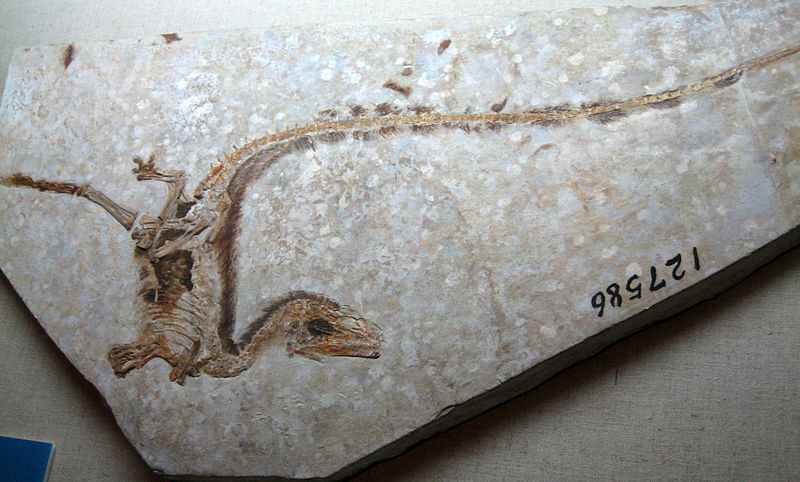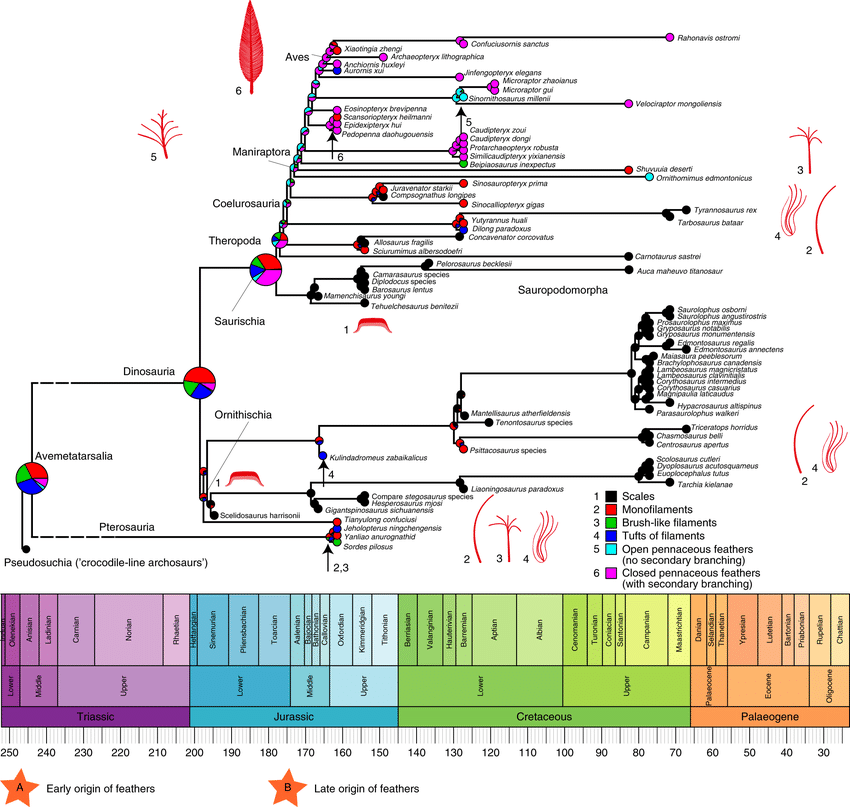By this point you are perhaps vaguely aware of the presence of feathers on these animals called birds. Does this accurately describe you? Read on!
These feathers didn’t come from just nowhere, and it turns out that at least a dozen dinosaur taxa more basal than birds are preserved with some sort of filamentous integumentary structures (that is to say, structures based in the integument that resemble filaments) which bear a remarkable homology to avian feathers! Just how far back do these “proto-feathers”, henceforth “feathers”, go? Here’s the story so far:
Some time after birds are invented, humans discovered both birds and feathers, and concluded that birds had (and have!) feathers.
The holotype of Archaeopteryx, a single feather, was found in 1861 to contain preserved remnants of a feather. This specimen, having been quarried from Tithonian limestone, reveals the existence of at least one feather 150 million years before the word “feather”.
Only a few years later, the rest of Archaeopteryx was described, revealing that feathers predated birds and were, in fact, present in at least one non-bird (and, contentiously at the time, also a dinosaur).
In the 1960s, the theropod Deinonychus was described and put forward as evidence that birds are also theropods. Further analyses support the inclusion, and throughout the 1970s feathers were believed to be present in all theropods.
Sinosauropteryx was described in 1996 alongside clear feather imprints, definitively bringing feathers to the coelurosaurs.

The ornithischian Tianyulong is found with, dubiously, a row of filamentous integumentary structures all along its back. Wait, an ornithischian? Everything else here is under Saurischia…
Despite uncertainty surrounding Tianyulong, Kulindadromeus comes along as another closely-related, fairly basal ornithischian with more clearly-preserved integumentary structures. If these are present in Ornithischia (or at least its basal members), then feathers must have originally been present in all of Dinosauria.
As recently as 2018, analysis of the pycnofibres (integumentary structures of pterosaurs) of exceptionally well-preserved anurognathids concludes they are “remarkably similar to feathers and feather-like structures in non-avian dinosaurs.” Which indicates that (primitive) feathers are quite possibly ancestral to dinosaurs, and their close relatives, and to dinosauromorphs altogether.

And who knows, maybe at some point an aphanosaur or close relative will be found preserved with a similar sort of covering. “Avemetatarsalia” is supposed to mean “bird metatarsals” (no, really!), but perhaps it shares even more with birds than immediately apparent.
At this point the term “feather” is really pushing it. But relaxing those standards even more, early precursors to feather development are indeed found in crocodiles and even squamates. According to this research, mammalian hair and avian maniraptoran coelurosaurian theropodan dinosaurian avemetatarsalian(⁇) feathers are both derived from the same anatomical features despite their manifest differences.
Perhaps even the flagella of bacteria will turn out to share some sort of phylogeny with feathers, at which point (being found present in prokaryotes) we’ll throw up our hands in resignation and proclaim that feathers are intrinsic to life and have existed since the very beginning. Or perhaps not.
No comments found.